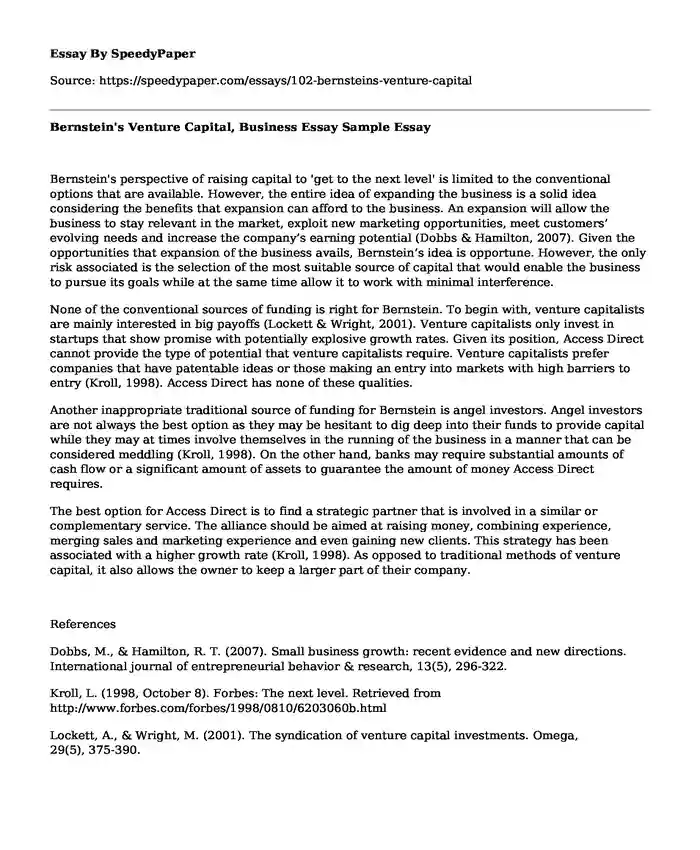Bernstein's perspective of raising capital to 'get to the next level' is limited to the conventional options that are available. However, the entire idea of expanding the business is a solid idea considering the benefits that expansion can afford to the business. An expansion will allow the business to stay relevant in the market, exploit new marketing opportunities, meet customers’ evolving needs and increase the company’s earning potential (Dobbs & Hamilton, 2007). Given the opportunities that expansion of the business avails, Bernstein’s idea is opportune. However, the only risk associated is the selection of the most suitable source of capital that would enable the business to pursue its goals while at the same time allow it to work with minimal interference.
None of the conventional sources of funding is right for Bernstein. To begin with, venture capitalists are mainly interested in big payoffs (Lockett & Wright, 2001). Venture capitalists only invest in startups that show promise with potentially explosive growth rates. Given its position, Access Direct cannot provide the type of potential that venture capitalists require. Venture capitalists prefer companies that have patentable ideas or those making an entry into markets with high barriers to entry (Kroll, 1998). Access Direct has none of these qualities.
Another inappropriate traditional source of funding for Bernstein is angel investors. Angel investors are not always the best option as they may be hesitant to dig deep into their funds to provide capital while they may at times involve themselves in the running of the business in a manner that can be considered meddling (Kroll, 1998). On the other hand, banks may require substantial amounts of cash flow or a significant amount of assets to guarantee the amount of money Access Direct requires.
The best option for Access Direct is to find a strategic partner that is involved in a similar or complementary service. The alliance should be aimed at raising money, combining experience, merging sales and marketing experience and even gaining new clients. This strategy has been associated with a higher growth rate (Kroll, 1998). As opposed to traditional methods of venture capital, it also allows the owner to keep a larger part of their company.
References
Dobbs, M., & Hamilton, R. T. (2007). Small business growth: recent evidence and new directions. International journal of entrepreneurial behavior & research, 13(5), 296-322.
Kroll, L. (1998, October 8). Forbes: The next level. Retrieved from http://www.forbes.com/forbes/1998/0810/6203060b.html
Lockett, A., & Wright, M. (2001). The syndication of venture capital investments. Omega, 29(5), 375-390.
Cite this page
Bernstein's Venture Capital, Business Essay Sample. (2018, Feb 04). Retrieved from https://speedypaper.com/essays/102-bernsteins-venture-capital
Request Removal
If you are the original author of this essay and no longer wish to have it published on the SpeedyPaper website, please click below to request its removal:
- Free Essay on Whether Today's Youth Are More Self-Centred Than Previous Generations
- Essay Example on Accommodation Sharing
- Law Essay Example for Your Use: Legal Issues in Criminal Justice
- Free Essay Example on Watershed Situation Description
- Psychology Essay Sample: The Environmental Effects of Crime in the African American community
- Essay Example Dedicated to China in the Global Film Industry
- Free Essay: Poverty and Security in South Asia
Popular categories





